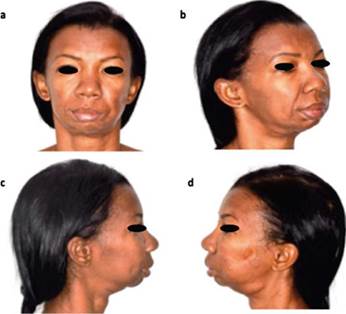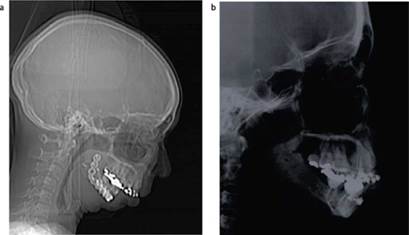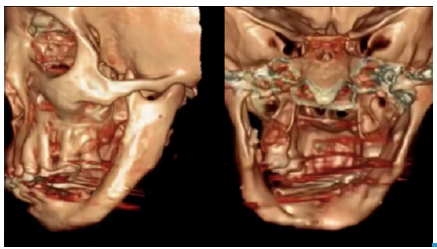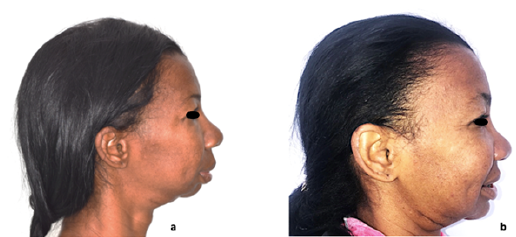INTRODUCTION
Although dentofacial anomalies are usually congenital, they may also be acquired by trauma, surgery, or during growth. In turn, segmental mandibular defects can be caused by gunshot wounds or as a result of ablative surgery of malignant or benign tumors. 1 These mandibular bone continuity defects have a major psychological and social impact on patients since they are associated with aesthetic and functional alterations that affect the patient's health status.
Mandibular reconstruction is essential in patients with mandibular defects because it improves or restores mandibular function and allows the placement of dental implants for the rehabilitation of masticatory function, thus improving the patient's health and quality of life. Several types of bone graft are used for mandibular reconstruction, including autologous non-vascular, allogenic, and xenogeneic bone grafts, as well as free tissue transfer via vascularized flap. 2 The most widely used donor sites for mandibular reconstruction are the radial forearm, scapula, iliac crest, and fibula. Each donor site differs in the amount of bone and soft tissue needed. 3
Literature or studies explaining or evaluating horizontal distraction of free iliac crest bone grafts, especially to solve problems such as micrognathia caused by firearm injury in children, is scarce. The combination of non-vascularized iliac crest bone graft and two-stage maxillary distraction osteogenesis has only been described to achieve alveolar ridge augmentation and subsequent dental implant placement and rehabilitation of masticatory function in the maxillary bones. Currently, there are no case reports of mandibular distraction using free iliac crest bone graft for the management of mandibular hypoplasia.
In the absence of reports evaluating horizontal distraction of free iliac crest bone grafts used specially to solve problems such as micrognathia as a consequence of childhood gunshot wound, we present the case of a patient with a gun-related injury, who required a free anterior iliac crest bone graft for mandibular reconstruction and horizontal graft distraction for correction of skeletal dentofacial anomaly.
CASE PRESENTATION
The present case is a 44-year-old black woman from Cartagena, Colombia, who was shot in the jaw when she was 1 year old. The patient did not receive reconstructive treatment until she was 40 years old, when she entered the Maxillofacial Surgery Service of the Instituto Roosevelt, in Bogotá, Colombia (Figure 1). Although the patient is currently employed as a merchant, she has limited resources due to her low socioeconomic status. The patient's treatment approach focused on mandibular reconstruction and not on having an adequate facial balance. The patient was explained that there were treatment options to achieve a better profile and she accepted the treatment proposed.

Source: Document obtained during the study.
Figure 1 First photo of the patient when she was admitted in 2016. An extremely convex profile is observed. a) Frontal photography, b) % photography, c-d) Profile photography. Severe mandibular micrognathia is observed.
Panoramic radiography and computed tomography were utilized as diagnostic aids. The intervention began in 2016 after performing a standard mandibular reconstruction with a non-vascularized iliac crest bone graft, integrating the graft without complications. Then, in 2018, bilateral mandibular distraction was started, including the free iliac crest bone graft. For mandibular distraction, distractors were placed, and mandibular osteotomy was performed in the center of the iliac crest graft. Latency was maintained for 7 days and distracted 1 mm daily thereafter. A distraction of approximately 28mm was carried out. In 2019, consolidation ended, and distractors were removed. As of August 2020, the patient had adequate mandibular function and there was no evidence of complications.
Adequate reconstruction of the arch shape and facial contour was achieved, but the patient presented a deficient masticatory function and, because of the affectation of mandibular growth due to the history of gunshot wound, she had a severe class II dentofacial anomaly with a dental discrepancy of 28mm (Figure 2).

Source: Document obtained during the study.
Figure 2 Free bone graft in position and patient with severe class II anomaly with a dental discrepancy of 28mm (a). Figure (b) shows the final discrepancy after distraction.
In 2018, the patient underwent a bilateral mandibular distraction, where the free iliac crest bone graft was distracted without complications (Figure 3).

Source: Document obtained during the study.
Figure 3: Panoramic radiographs (a) Initial radiography taken in 2012; (b) Radiography with bilateral mandibular distractors; (c) radiography taken at the end of the mandibular free graft bone distraction.
The patient currently has an adequate profile, favorable facial harmony and adequate maxillomandibular relationship (Figures 4 and 5). Moreover, the patient is on a plan to rehabilitate masticatory function using implant-supported fixed dental prostheses. The patient has been attending follow-up appointments every 6 months since the last intervention, and no complication has been observed after two years.

Source: Document obtained during the study.
Figure 4 Three-dimensional facial reconstruction after free iliac crest bone graft distraction. Adequate maxillomandibular relationship and mandibular contour.
DISCUSSION
Segmental bone loss in the craniofacial region can result from blast injuries, gunshot wounds, blunt trauma, tumor removal, or repeated surgical debridement for the treatment of tumor or infectious diseases. 4
Multiple techniques are used for mandibular reconstruction, including microvascular free flap, bone grafts, and bone distraction, which are widely used depending on the defect. Throughout history, the iliac crest bone graft has been used for both maxillary and mandibular reconstruction. This technique is indicated in non-irradiated jaws with mandibular defects of up to 5cm reconstructed with an anterior iliac crest bone and up to 10cm if reconstructed with posterior iliac crest bone. 2,3
Another technique for mandibular reconstruction is osteogenic distraction bone neoformation, a process in which the formation of new bone is gradually induced by a device that is placed between two bone surfaces. This technique was initially described by Codivilla in 1904, 5 but Ilizarov popularized it by creating a device for the surgical lengthening of long bones in 1951. 3
Osteogenic distraction is a slow, progressive, and continuous biological process that involves the formation of new bone between bony segments that are gradually separated by incremental traction. Regarding this process, it has been documented that there is not only bone formation, but also tissue formation under tension stress, including mucosa, skin, muscles, tendons, cartilage, blood vessels and peripheral nerves, which explains why it is currently called distraction histiogenesis. 5-8
The combination of non-vascularized iliac crest bone and distraction osteogenesis of the graft in a second surgical intervention has been described for alveolar ridge augmentation and subsequent implant placement and rehabilitation of masticatory function. 9
However, horizontal distraction of a free iliac crest bone graft for treating dentofacial anomalies and gunshot injuries has not been described to date. The clinical case presented here aims to propose this technique as a safe alternative in the management of similar cases, as it is considered to be a safe procedure, with similar behavior to the native jaw of the patient.
CONCLUSIONS
Iliac crest bone graft distraction as a treatment for dentofacial deformities is a safe and predictable procedure that can be performed in patients that require reconstructive treatment with horizontal mandibular distraction. The authors consider that it is a safe procedure, although more cases and studies are needed to acquire scientific evidence.















